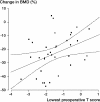Female patients with low systemic BMD are prone to bone loss in Gruen zone 7 after cementless total hip arthroplasty
- PMID: 19916684
- PMCID: PMC2823339
- DOI: 10.3109/17453670903316801
Female patients with low systemic BMD are prone to bone loss in Gruen zone 7 after cementless total hip arthroplasty
Abstract
Background and purpose: Factors that lead to periprosthetic bone loss following total hip arthroplasty (THA) may not only depend on biomechanical implant-related factors, but also on various patient-related factors. We investigated the association between early changes in periprosthetic bone mineral density (BMD) and patient-related factors.
Patients and methods: 39 female patients underwent cementless THA (ABG II) with ceramic-ceramic bearing surfaces. Periprosthetic BMD in the proximal femur was determined with DXA after surgery and at 3, 6, 12, and 24 months. 27 patient-related factors were analyzed for their value in prediction of periprosthetic bone loss.
Results: Total periprosthetic BMD was temporarily reduced by 3.7% at 3 months (p < 0.001), by 3.8% at 6 months (p < 0.01), and by 2.6% at 12 months (p < 0.01), but recovered thereafter up to 24 months. Preoperative systemic osteopenia and osteoporosis, but not the local BMD of the operated hip, was predictive of bone loss in Gruen zone 7 (p = 0.04), which was the only region with a statistically significant decrease in BMD (23%, p < 0.001) at 24 months. Preoperative serum markers of bone turnover predicted the early temporary changes of periprosthetic BMD. The other patient-related factors failed to show any association with the periprosthetic BMD changes.
Interpretation: Female patients with low systemic BMD show greater bone loss in Gruen zone 7 after cementless THA than patients with normal BMD. Systemic DXA screening for osteoporosis in postmenopausal patients before THA could be used to identify patients in need of prophylactic anti-resorptive therapy.
Figures




Comment in
-
Female patients with low systemic BMD.Acta Orthop. 2010 Dec;81(6):768; author reply 769. doi: 10.3109/17453674.2010.537811. Acta Orthop. 2010. PMID: 21110706 Free PMC article. No abstract available.
References
-
- Aldinger PR, Sabo D, Pritsch M, Thomsen M, Mau H, Ewerbeck V, Breusch SJ. Pattern of periprosthetic bone remodeling around stable uncemented tapered hip stems: a prospective 84-month follow-up study and a median 156-month cross-sectional study with DXA. Calcif Tissue Int. 2003;73:115–21. - PubMed
-
- Bhandari M, Bajammal S, Guyatt GH, Griffith L, Busse JW, Schünemann H, Einhorn TA. Effect of bisphosphonates on periprosthe tic bone mineral density after total joint arthroplasty. A meta-analysis. J Bone Joint Surg (Am) 2005;87:293–301. - PubMed
-
- Dequeker J, Aerssens J, Luyten FP. Osteoarthritis and osteoporosis: clinical and research evidence of inverse relationship. Aging Clin Exp Res. 2003;15:426–39. - PubMed
-
- Eastell R, Robins SP, Colwell T, Assiri AM, Rigg BL, Russell RG. Evaluation of bone turnover in type I osteoporosis using biochemical markers specific for both bone formation and bone resorption. Osteoporosis Int. 1993;3:255–60. - PubMed
-
- Glowacki J, Hurwitz S, Thornhill TS, Kelly M, LeBoff MS. Osteoporosis and vitamin-D deficiency among postmenopausal women with osteoarthritis undergoing total hip arthroplasty. J Bone Joint Surg (Am) 2003;85:2371–7. - PubMed
Publication types
MeSH terms
LinkOut - more resources
Full Text Sources
Medical
